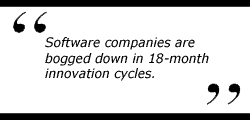The Future of Enterprise Software
The software industry should adopt a Web-based distribution system to accelerate innovation and serve customers better.
The software industry's economic model makes no sense. First, applications are built on proprietary standards, which prevent separate programs from working together and make upgrades costly. Second, applications are sold through indirect channels and direct sales forces, an approach that boosts marketing expenses and doesn't use the Internet as a low-cost distribution channel. The model is a serious obstacle to innovation — of every dollar paid for software, about 50 to 60 cents covers the vendor's sales and marketing costs, whereas only about 15 cents goes into R&D to create better products.
Over the next three to five years, the Internet is going to shake up this model. Through digital delivery, software developers will activate new application features on customers' servers, rather than require customers to replace an old version with a new one across multiple IT systems. Developers can sell software as a service, greatly lowering the costs of software distribution and increasing operating efficiency. No longer burdened with installation duties, customers can focus on how to use new features to transform their operations.

The ease of updates will force software developers to become more innovative. Currently, major software companies run on 18-month cycles, bogged down because new versions of software must be separately customized for each customer. With the Internet-enabled model, software makers could upgrade applications at any time and deliver them immediately. Software companies that move in this direction will become incredibly competitive because the innovations will drive their success.
At the same time, higher quality software will allow companies to become more virtual, and that will free them from cumbersome business processes. For example, the costly departments that oversee order management, purchasing, finance, and human resources won't be needed to process transactions anymore. However, professionals in these areas will be needed to analyze business issues, but companies will need fewer (but smarter and more experienced) people.
Using the Internet to handle routine business transactions is bound to happen because the cost savings are so compelling. It costs $1 for an accounting department to physically produce and mail an invoice to a customer, who pays with a handwritten check. If the bill is presented and paid electronically through direct payment, the cost falls 90 percent, to 10 cents.
Likewise, automating transactions can take millions, even billions, of dollars in process costs out of supply chains. The automotive and aerospace industries, to take two examples, have billions of dollars of excess inventory, due to off-base forecasts. With supply chain software, customer demand will more accurately determine production targets and the excess inventory will melt away. That type of impact makes Web-driven software innovation more logical than ever.
| Authors
Ray Lane, rlane@kpcb.com Ray Lane is general partner of the venture-capital firm Kleiner Perkins Caufield & Byers. A former Booz-Allen & Hamilton senior partner, he previously served as president and chief operating officer of the Oracle Corporation. |


